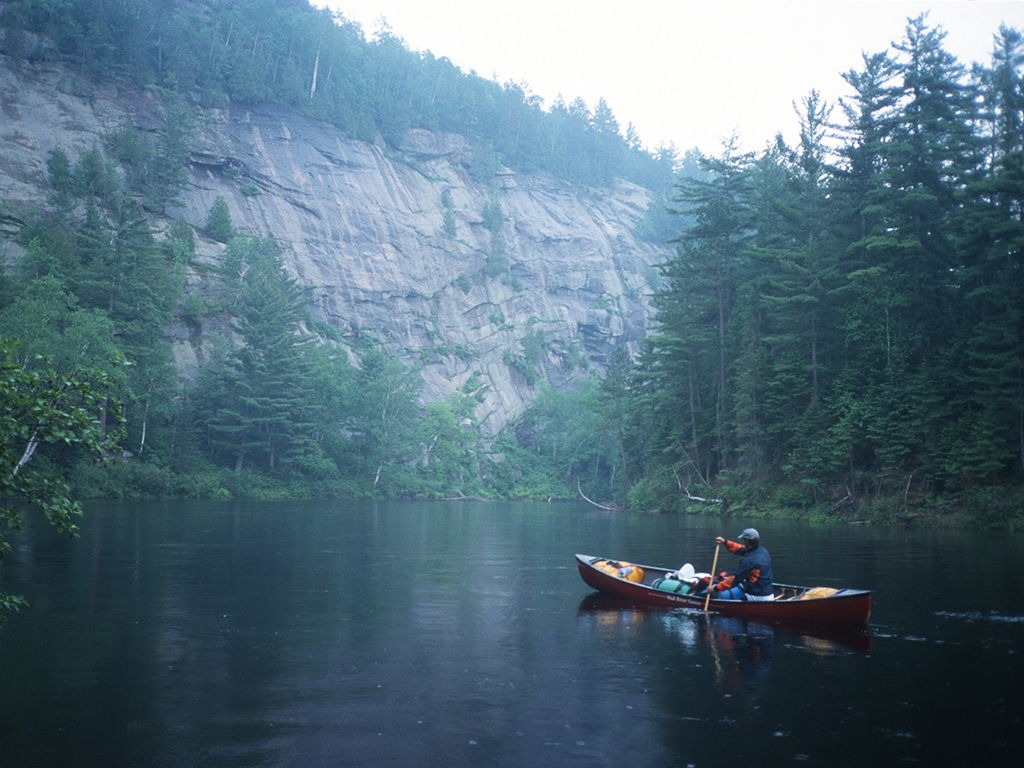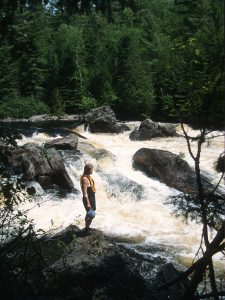The Dumoine River has a place in history as an important travelling route for the Algonquin natives, and environmentalist see it as an irreplaceable wilderness area, but I have to admit that I wasn’t really thinking about any of that as the current pulled us closer to the top of a rather large set of rapids called Canoe Eater.
It was the second day of a paddling trip down one of the area’s most popular whitewater rivers with my wife and her two brothers, Jan and Preben, the latter nervously gripping his paddle in the bow of the canoe as I steered us into the frothing whitewater. The boat bucked wildly as we paddled clear of submerged boulders but took on more and more water as waves pummeled the canoe. In no time, the boat was totally filled. And we still had half the rapids to get through.
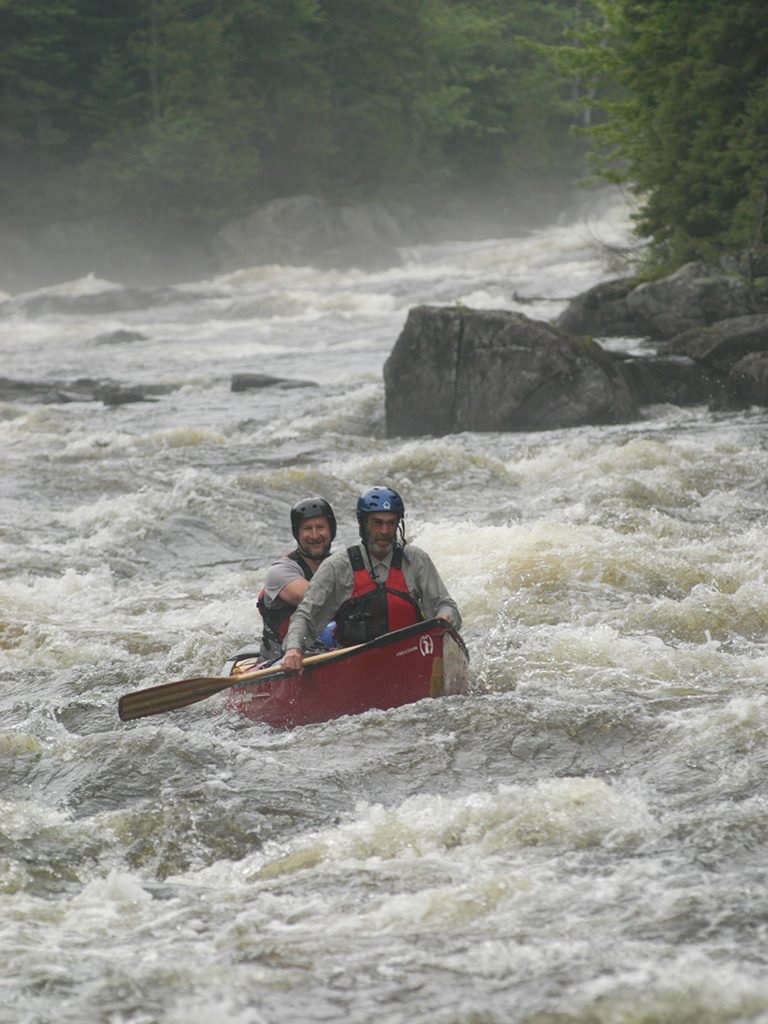 On the first run of Canoe Eater with Jan, we didn’t take on nearly as much water – the canoe we were paddling is built for running big rapids – but on the second attempt with Preben, we paddle in on I dubbed “Red October” years ago(after the movie about a submarine) for its habit of filling up on every rapids. Even though we used four waterproof barrels in each canoe to hold our equipment and help displace water, the boat was still uncontrollably heavy, and was submarining straight for a shoreline cliff and a large tree that had fallen part way into the river.
On the first run of Canoe Eater with Jan, we didn’t take on nearly as much water – the canoe we were paddling is built for running big rapids – but on the second attempt with Preben, we paddle in on I dubbed “Red October” years ago(after the movie about a submarine) for its habit of filling up on every rapids. Even though we used four waterproof barrels in each canoe to hold our equipment and help displace water, the boat was still uncontrollably heavy, and was submarining straight for a shoreline cliff and a large tree that had fallen part way into the river.
We narrowly avoided smashing against the cliff wall and somehow squeezed under the fallen tree and out to safety. Canoe Eater decided not to have us for dinner, after all.
The previous day had been a little tamer as we drove north on logging roads and listened to stories fromout shuttle drive, Noel Leclerc, about some colourful locals Marilyn and I met on previous canoe trip s on the Dumoine’s nearby rivers – the Coulonge and Noire rivers – which also flow from LaVerendrye Wildlife Reserve south of to meet the Ottawa River.
While the Noire boasts some beautiful scenery and the Coulonge is an excellent weekend paddle, the Dumoine stands out among the others because of its many personalities – tranquil lakes, towering granite cliffs, the unforgettable Grand Chute falls and more than 30 sets of rapids.
The rapids range from easy to advanced level of whitewater paddling ability. There are portages around every set if you want to play it safe, but some of the trails are rough going. The worst – and only because it is so long – is the portage around Gand Chute. The main portage trail is 1.5 kilometres, which we walked three times to get our gear and the boats to the bottom. In all it took us two hours and seven-and-a-half kilometres.
The Dumoine is the last undammed wild river in southern Quebec and flows through the largest tract of southern boreal forest in the province. The Canadian Parks and Wilderness Society calls the land a crucial wildlife corridor from La Verendrye Reserve to Algonquin Park and further south to the Adirondack and Appalachian Mountains in the U.S.
In May of 2007, the Quebec government agreed, announcing that a 1,450 sq. km. swath surrounding the river would be protected from all types of commercial exploitation such as logging and mineral exploration. The announcement was part of a decision to protect a total of 18,000 sq, km. of new areas throughout Quebec. By the end, of that year, the government hoped to designate eight per cent of the province as protected land.
“There not much logging going on anymore around here, anyway – the cost if it now is not worth the trouble,” said Leclerc, a former logger who has lived in the area his whole life and remembers years ago when “there were so many logs on the river you could run across to the other side.”
These days, the Dumoine and its lakes are more popular for fishing, hunting, and canoeing. The river can be paddled from spring to fall and guided trips are offered by several outfitters.

Many visitors once flew into one of the lakes on the river from a float plane base in Rapides des Joachims, an island community on the Ottawa River in Quebec near Rolphton, but with flying getting increasingly expensive, most people, including us opted for a three-hour ground shuttle to a put-in at a bridge just north of Lac Benoit.
We met Leclerc at Driftwood Provincial Park on Highway 17 just northwest of Deep River, moved our canoes and equipment to his truck and left our van there, meaning a two-kilometre paddle across the often windy and white-capped shallow Ottawa River back to the park at the end of the trip.
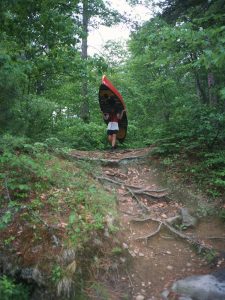 It’s also possible to have your vehicle waiting for you at Grand Chute, about 20 kilometres upriver, and avoid the strenuous Ottawa River crossing and the grueling portage around the falls, but there is some breathtaking scenery below grand Chute and some excellent whitewater to run, particularly a long stretch called Red Pine rapids. The Dumoine is home to a variety of animals such as beavers, muskrats, deer and wolves that live among the black spruce, red and white pine, pockets of white cedar and birch, so that chance of spotting one of them is fairly good, Birds are more common on the river, including loons, belted kingfishers and red breasted mergansers.
It’s also possible to have your vehicle waiting for you at Grand Chute, about 20 kilometres upriver, and avoid the strenuous Ottawa River crossing and the grueling portage around the falls, but there is some breathtaking scenery below grand Chute and some excellent whitewater to run, particularly a long stretch called Red Pine rapids. The Dumoine is home to a variety of animals such as beavers, muskrats, deer and wolves that live among the black spruce, red and white pine, pockets of white cedar and birch, so that chance of spotting one of them is fairly good, Birds are more common on the river, including loons, belted kingfishers and red breasted mergansers.
On the fourth day , we were paddling down the strong current, passing shores of dense over grown bush under tall straight pines with the occasional hunt camp tucked in the forest, and looked up to see a bald eagle soaring over the river in search of fish. Our canoes rounded a corner and a surprised lone female moose stared up at us from the riverbank. We paddle to the far side of the river as it moved into the safety of the forest, only to come out again further downstream.
Unfortunately, in June the Dumoine is also a great place to see hordes of blackflies and mosquitoes. Newspaper reports suggested the weather was perfect for an explosion of bug breeding while we were on the river, so we took precautions and brought custom-sewn bug netting that hung down dorm our tarp and was large enough for four people to sit under.
Well, it runs out the only encounter with nasty creatures was a wolf spider almost the size of the palm that guarded the lids of an open air toilet – or “thunderbox,” in paddler’s terms – I was about to use. There are thunderboxes at most of the campsites on the Dumoine and many are new and usually more welcoming.
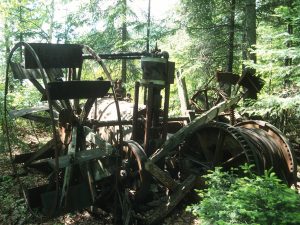 Instead, each evening, we would wonder where the bugs were – quietly, of course, not to jinx ourselves – thank our luck stars and enjoy some fantastic campsites. One night, we even set up the netting for the fun of it and sat outside the door wondering how it would work and when the day would come when we’d find out
Instead, each evening, we would wonder where the bugs were – quietly, of course, not to jinx ourselves – thank our luck stars and enjoy some fantastic campsites. One night, we even set up the netting for the fun of it and sat outside the door wondering how it would work and when the day would come when we’d find out
What we did get was a lot of cool we weather, which wasn’t much of a bother since we had the tarp and plenty of extra warm clothes and rain gear. Warm swells of wind also created mist over the river for two days that was mysterious and beautiful.
The rain certainly didn’t stop Jan from fishing and one afternoon on Burnt Lake in the driving rain, he hooked on to a small bass and later that day, the same good-sized speckled trout twice, which promptly took his lure and was never seen again. There are also pickerel and pike to be had in the lakes of the Dumoine and Jan trolled as we paddled, keen to have a dinner of freshly caught fish.
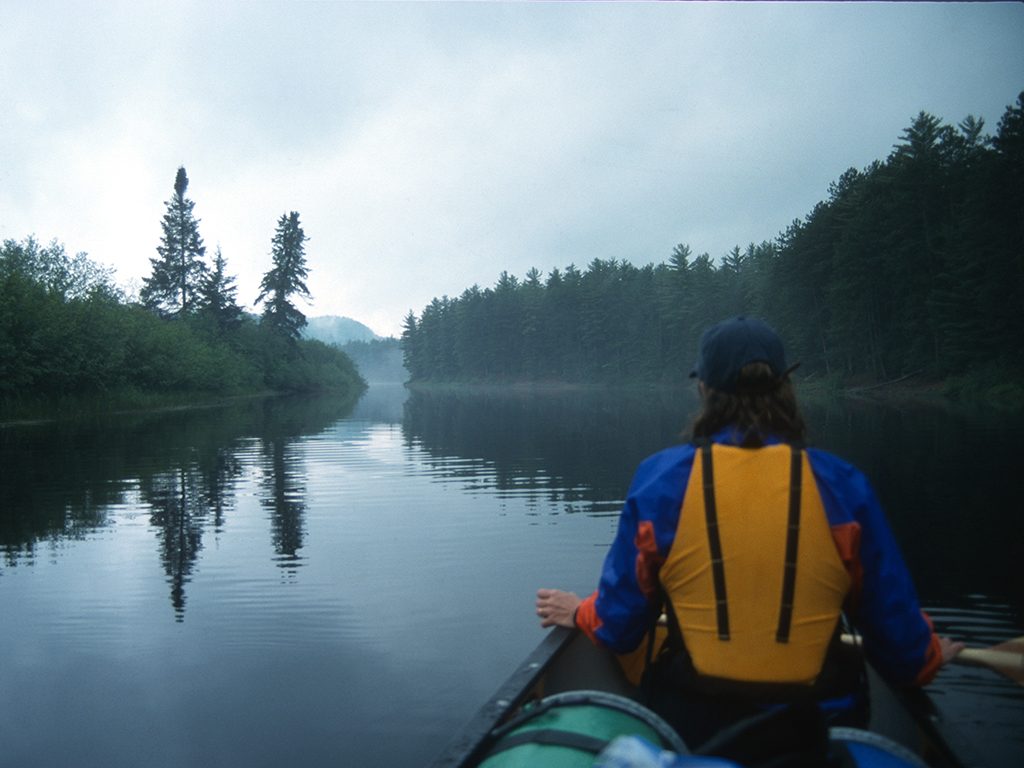
We almost needed it one day while lifting the canoes over one of a few unrunnable chutes and falls on the trip. As Preben and I were pulling one of the loaded canoes along the edge of the chute, the bow dipped into the water and the canoe quickly filled with water, promptly ejecting a paddle and a zip-locked bag of dehydrated spaghetti sauce into the chute. After frantically rescuing the canoe from also going in, we watched the paddle float downriver while the dinner bag got caught in a current that put it through nature’s washing machine three times before we lost sight of it again. Surprisingly, and the makers of Zip Lock bags will be proud to hear, we discovered the bag hooked onto a log in a nearby eddy, intact and read to eat. There is a lot to be said for double–bagging essential items.
By then, we were nearing the end of the trip and heading towards our final campsite overlooking a waterfall a few kilometres from the Ottawa River. The last of the whitewater was behind us, the sun had finally made an appearance, if only for the day, and we tied the canoes together and floated down continuous swifts, recounting the rapids we had run – Big and Little Steel, Examination, Cliff Hanger, the Snake, the Sleeper, and Thread the Needle.
Despite not having much experience whitewater canoeing, Jan and Preben had paddled together down every rapid except the largest without dumping, and I could hear the sense of accomplishment and excitement in their voices as we talked. The Dumoine River offers that kind of experience – the serenity of a quiet misty morning, the adrenaline rush of running a powerful and unpredictable rapid, and the stories that come from a wilderness canoe trip. The best part is that this world class river lies only a few hours drive from Ottawa. This was the fourth time Marilyn and I had paddled it, and we’ll be back again with our oversized mosquito net and double Zip-locked bags of food, thankful that the Dumoine is now a protected area.
Story by Ralph Plath
Photos by Ralph Plath
and Marilyn Mikkelsen
Getting There and Back
Ground Shuttle:
The main put-in for a ground shuttle is just north of Lac Benoit but talk to the shuttle company for other options. A popular take-out is the Pine Valley Resort and Campground or Driftwood Provincial Park about 15 kilometres north of Rolphton on Highway 17. The park charges $11 per night to leave your vehicle. For a shorter trip, leave your vehicle at the Grand Chute ZEC office.
Dumoine River Expeditions
– website – http://www.dumoine-exp.ca
– tel. – 613-586-2562 or 613-717-0115
– email – dumoine.river.exp@hotmail.com
If you would like to try the shuttle on your own it is recommended to have a vehicle with good suspension and lot’s of ground clearance. There are now signs along the logging roads to the put-in. Consult the book Backroad Mapbook of Southwestern Quebec for navigational assistance.
Self Guided trips:
Hap Wilson’s book “Rivers of the Upper Ottawa Valley” is an excellent resource with detailed maps of each rapid.
Guided trips:
Here are a just a few of the companies that offer trips:
Black Feather
– website: www.blackfeather.com
– tel: (705) 746-1372
or toll free: 1-(888) 849-7668
Dumoine Valley Guides:
– website – http://www.dumoinevalley.ca
– tel: 613-586-2300
– email: guide@dumoinevalley.ca
Wanapeiti Canoe and Northern Outdoor Expeditions Adventures:
website – http://www.wanapiteicanoe.com
– tel: 1- (705) 652-3199
– email: trips@wanapiteicanoe.com
